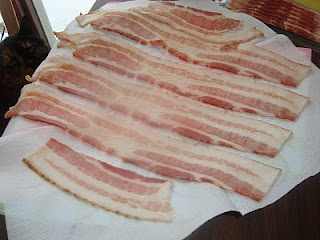**Warning to all readers--I'm writing these blog posts spectacularly out of order and I'm posting them as I write them, so if you aren't reading this in a blog reader (which will pick them up regardless of when I post them) and aren't a fan on Facebook (I will FB when I post), keep checking back**
Much like Rachel a couple of weeks ago, my father decided that it was his duty to help me knock as many TJOC-related cocktails off the list as he could. My dad had the opposite problem that Rachel had--he had a fully stocked bar but no juices, which causes a real problem with TJOC cocktails. We essentially had 7 cocktails we could make. And, since Dad has been on the Adkin's Diet for over ten years, he couldn't drink any of the cocktails anyway. So my poor stepmother had to step up to the plate. Fortunately for me, she was willing to drink gin! It seems nobody else I know is willing to do so.
(And, like the last all-alcohol post, I am going to include fun facts!)
The first drink was a Gin cocktail (p. 56).
Facts about gin (Wikipedia):- The predominant flavor of gin comes from juniper berries
- Monks used a juniper-flavored alcohol similar to gin as a medication for the bubonic plague (it did not work)
- Because gin is relatively easy to produce, it was a favorite during Prohibition
- "Sloe gin" is infused with sloes, which are the fruit of the blackthorn
I shook gin, orange juice, lemon juice, and a dash of bitters together, and strained it over ice:

Vickie said it was good but a little too sour. I've noticed that gin drinks do tend towards sour rather than the fruity.
For some mysterious reason I was mixing the drinks in a Hidden Valley ranch shaker even though Dad has a fully stocked wet bar complete with real shakers. And I was totally sober. I must have been tired. I didn't take a picture of the next drink for some reason. The next drink I made her was a Bronx (p. 56).
Bronx factoids (Wikipedia):- A Bronx is a perfect martini with orange juice
- The Bronx was a very popular cocktail during prohibition
- Vermouth was originally used to cover up the flavors of cheap wine
I shook gin with a dash of sweet vermouth, a dash of dry vermouth, and orange juice. I strained it in to a cocktail glass. It was very gin-y. This is a cocktail to avoid if you don't love drinking gin. It's almost completely gin.

Dad was pretty excited about the recipe for the Rusty nail (p. 60).
Rusty nail facts (Wikipedia):- A rusty nail is commonly drank as both as a cocktail and as a martini
- The Canadian version of the drink substitutes rye whiskey for the Scotch and is called a Donald Sutherland
- Drambuie is a honey and herb flavored malt whiskey
Dad favors Scotch and really likes Drambuie--so a drink that is 3/4 Scotch and 1/4 Drambuie is perfection:

He loved it! The honeyed flavor of the Drambuie mixed perfectly with the Scotch. Dad said he'll remember this recipe for the future because he loved it that much. Drinks with only two ingredients are called "duos" and they are excellent if you really like both ingredients.
Vickie asked to if she could have something other than gin so I made her a Brandy Alexander (p. 62).
Brandy Alexander facts (Wikipedia):- The brandy alexander is based on the "Alexander" which is gin based
- If the drink is made with light creme de cacao, it's considered a "Panama"
- The "creme" in creme de cacao refers to the texture of the liqueur--there are no dairy products in it
I shook brandy, dark creme de cacao, and a dash of heavy cream together and then strained it in to a glass:

She liked it! I think sometimes Brandy Alexanders are ice cream drinks, which I would now love to have because I think it would be delicious. I really like chocolate based drinks so it was right up my alley.
I decided that maybe I should mix myself a drink and Planter's punch (p. 61) caught my eye.
I shook rum, orange juice, grenadine, lime juice, and a bit of sugar (Dad didn't have sugar syrup and I didn't want to make it) together and then strained the drink over ice:

Another drink that goes down
way too easy. I liked it a lot. The rum was perfectly matched with the fruit flavors and it wasn't overly sour. Delicious! TJOC has a large punch recipe for planter's punch, too, and I was looking forward to it.
Unfortunately, I found out while drinking the planter's punch that I am allergic to rum, too (I imagine it has something to do with fruit flavors or extracts in the alcohol) so that stopped my love of the planter's punch. I'm really hating my fruit allergy and it really seems to be expanding.
Any favorite cocktails? Dad, you want to jump in with your thoughts?




















































